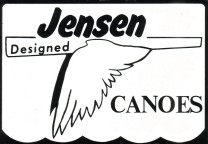Master paddler, canoe builder and designer and creator of the bent shaft paddle, Eugene ‘Gene’ Jensen passed away at the age of 75 at his Inverness, Florida home last month.
When XY Paddle managers Spencer and Samantha Meany heard about the memorial for the father of the modern canoe and bent shaft paddle, they knew they just had to be there to represent the Canoeing Capital of Canada. This meant leaving a wedding in Thunder Bay at 12:30 a.m. so they could attend the ceremony the next day. It was an experience neither will ever forget.
“They thought it was incredible that a young couple from Atikokan who had never met Gene would be there,” said Spencer. “We introduced ourselves to his son and when we said that we make canoe paddles in Atikokan he said, ‘So you too have something to be thankful to my father for.’ That’s his legacy.”
“We never met and we felt like we knew him after we left,” said Sam. “I was crying at lots of the stories, the impact he had on people’s lives as a friend, paddler and person.”
The memorial was held in Ken Ketter’s back yard (of Ketter Canoeing), which backs onto the Mississippi River , and from which Jensen put in and tested hundreds of canoe designs. Over 500 canoe racers and enthusiasts attended the ceremony, which was held at the same time as the Jensen Handicap, an annual canoe race that pairs professional racers with novice paddlers.
Samantha Meany took part in the race with Mike Cichanowski, the founder of We-no-nah Canoe and primary manufacturer of Jensen’s boat designs.
“I just happened to get Mike. I wasn’t intimidated because I didn’t know who he was until after the race,” she said.
In one anecdote, Jensen and Hassel were taking part in a world championship when the canoe behind them, paddled by Buzz and Steve Peterson, hit their rear end. The bow got stuck on a nearby boom log and when the paddlers kept going, Jensen’s canoe got turned completely around.
“Gene had a very colourful vocabulary,” said Spencer. “Gene let them know what he thought about it. Peterson said, let’s get out of here; we’re in trouble.”
Gene, paddling in the bow, apparently kept up a steady stream of invective and the Petersons thought they had a good idea of how far behind their rivals were by the sound of his voice. However, Hassel and Jensen had fooled them. Jensen’s voice only sounded like the canoe was a canoe-length behind because instead of turning around, he and Hassel merely put their power into paddling backwards, and so caught up to and then passed their errant opponents.
In another race, Jensen dropped his canoe on a rock, bashing a big hole in the side. Even knowing he had no chance of winning the contest, Jensen took off his shirt and shoes, stuffed them in the hole and kept going.
Jensen was determined to have the fastest canoe, the fastest paddle and the fastest technique so that he could win races. He was delighted to see other people adopt his methods, but it also meant he had to keep one step ahead of them with even better designs.
“Dan Hassel designed a canoe that was a world champion, so Gene went out and built a faster one. They were all motivated by him.”
Jensen was one of the original competitors in the Atikokan-Ely canoe race, and his wife Audrey noted that he had routes mapped all through Quetico Park . In order to prepare for the night-time aspects of the race, Jensen would work out how long it would take to cross a lake, then set his alarm clock for their estimated time of arrival. When the alarm went off, he started looking for the portage.
“He was an unbelievable craftsman - he used quite primitive tools, considering the work he did - with loads and loads of [canoe] forms up in the rafters [of his shop]. He was a humble man, as most craftsmen are. His work ethic was unbelievable. He revelled in the fact that 99% of the people paddling against him were younger than he was,” said Robert Boileau, a former Atikokanite who, in the 1970s, dreamed of beating Jensen in the Atikokan-Ely race.
That goal turned out to be impossible. Jensen won the first race with partner Buzzy Peterson and his position in the winners’ circle was never successfully challenged by local paddlers. Despite this, his victories produced no rancour, because he behaved with consistent courtesy toward his opponents.
“He was always around to shake hands with the last place person,” Spencer said.
Anyone familiar with We-no-nah Canoes are familiar with Jensen’s work, because it was his designs that formed the backbone of the modern canoe industry. A canoe racer, Jensen was always looking to make faster, sleeker, more efficient crafts, and his designs helped propel the development of more efficient recreational canoeing as canoe makers adopted his patterns. But creating innovative canoe designs was only part of the gifts Jensen left for paddlers.
In 1949 Jensen and a partner moved away from using the slower J-stroke method of steering in favour of switching paddling sides, an advance that won them an important race in Quebec . The pair was also the first to use a quick ‘hut’ call to signal a side switch, and the following year in Quebec , the air was filled with the guttural sound as paddlers emulated Jensen.
In 1971 he created the bent shaft paddle, an invention that maximized paddle force and banished the straight paddle from racing forever. The first bent paddle was greeted with laughter by his competitors but when Jensen won yet another race, the laughter changed to a determined effort by paddlers everywhere to get themselves one of the wacky looking blades.
Jensen’s first race was in 1948, a brutal 450-mile marathon from Bemidji to Minneapolis on the Mississippi River . He went on to race in hundreds of competitions, and was still racing 20 times a year at age 65.
“Gene’s advice to [another paddler] was: first of all it takes five years to learn how to paddle; it takes three years to figure out that you don’t know what you’re doing,” said Spencer.
By Jacqueline Boileau
Atikokan ( Ontario ) Progress


